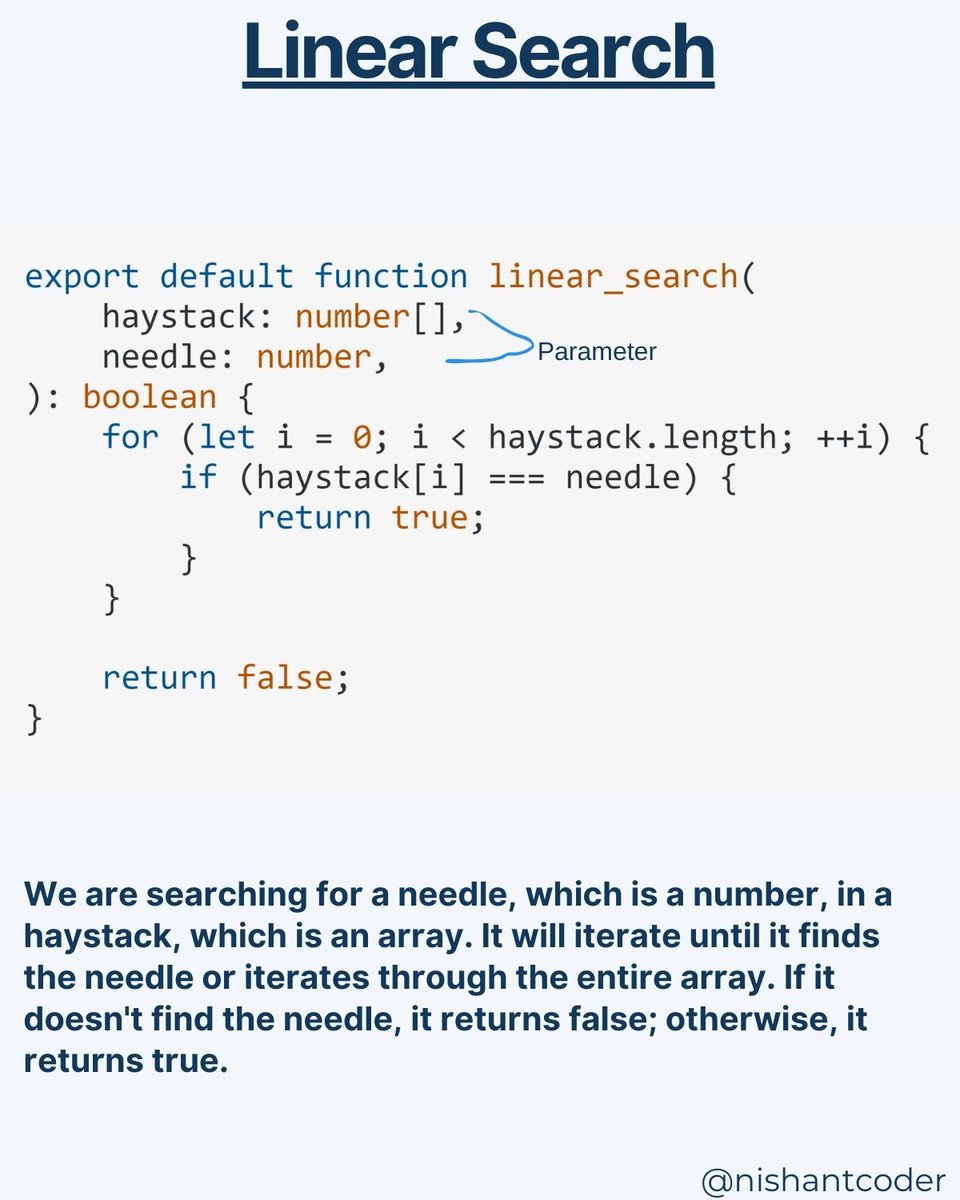#nishantcoder ผลการค้นหา
Learn Bubble Sort from @ThePrimeagen. It accepts an array as a parameter, iterates through the entire array using a loop, and within this loop, it iterates again with a nested loop. If the current value is greater than the next value, it swaps them. #BubbleSort #nishantcoder

Linear search is like scanning a book page by page to find a specific word. It goes through each element in a list one by one until the target is found. It's simple but not efficient for large datasets. #LinearSearch #SearchingAlgorithms #nishantcoder #dsa #ThePrimeagen #coding

Binary Search is a way to find something (like a number) in a sorted list or array. It works by repeatedly dividing the list in half and quickly narrowing it down to the desired item. #BinarySearch #nishantcoder #searching #algorithm #ThePrimeagen #CodingJourney #100DaysOfCode

Queue 👉 First In First Out [FIFO] 👈 Here, a #queue data structure is implemented in #typescript in the form of a linked list. First, we create the structure of a node type. Then, we create a class ... #nishantcoder #LearnInPublic #CodingJourney #dsa 1/5 🧵
![NishantWeb3's tweet image. Queue 👉 First In First Out [FIFO] 👈
Here, a #queue data structure is implemented in #typescript in the form of a linked list.
First, we create the structure of a node type. Then, we create a class ... #nishantcoder #LearnInPublic #CodingJourney #dsa
1/5 🧵](https://pbs.twimg.com/media/F-QTaQFWgAAs0U8.jpg)
Stack : Last In First Out [LIFO] here, we first create type of node. we create #Stack class in #typescript inside this declare the private and public property name head and length that can store the value of type Node<T> #nishantcoder #LearnInPublic #DSAWithNishant 1/4 🧵
![NishantWeb3's tweet image. Stack : Last In First Out [LIFO]
here, we first create type of node. we create #Stack class in #typescript inside this declare the private and public property name head and length that can store the value of type Node&lt;T&gt;
#nishantcoder #LearnInPublic #DSAWithNishant
1/4 🧵](https://pbs.twimg.com/media/F-QY_S3XUAAWZ1a.jpg)
Pop Method: Removing from the top. Condition, If the length is equal to 0, we first store the head, and then the head will be set to undefined. If the length is not equal to zero, we update the head with the previous node of the current head. #nishantcoder #LearnInPublic 3/4🧵
both the head and tail with the created node. If the tail exists, the tail's next node will be the current node, and then the tail will be updated to this new node. In deque: We remove an element from the front. Here, if the head is undefined ... #nishantcoder #dsa 4/5🧵
In enqueue: We add an element from the last or the back (tail) node. So, here, we first create a node, and its value is updated by the item coming from the parameter. Now, we check the condition: if the tail is undefined, then we update ... #nishantcoder #LearnInPublic 3/5 🧵
Peek Method: It allows viewing the top item without removing it. #nishantcoder #LearnInPublic #DSAWithNishant #stack #CodingJourney #100DaysOfCode #ThePrimeagen #frontend #dsa 4/4 🧵
it will return undefined; otherwise, we store the head in a constant variable, and then the head will be updated to head's next. In peek: We get the element before removing it from the front. #nishantcoder #LearnInPublic #ThePrimeagen 5/5 🧵
where we define public properties for length, and private properties for head and tail. We create a constructor where we initialize the initial values. Additionally, we create methods for enqueue, deque, and peek. #nishantcoder #LearnInPublic #dsa #100DaysOfCode 2/5🧵
Thanks a ton, @FrancescoCiull4 ! Your expertise has opened new doors for me in containerization. #Docker #LearningJourney #NishantCoder

Peek Method: It allows viewing the top item without removing it. #nishantcoder #LearnInPublic #DSAWithNishant #stack #CodingJourney #100DaysOfCode #ThePrimeagen #frontend #dsa 4/4 🧵
Pop Method: Removing from the top. Condition, If the length is equal to 0, we first store the head, and then the head will be set to undefined. If the length is not equal to zero, we update the head with the previous node of the current head. #nishantcoder #LearnInPublic 3/4🧵
Stack : Last In First Out [LIFO] here, we first create type of node. we create #Stack class in #typescript inside this declare the private and public property name head and length that can store the value of type Node<T> #nishantcoder #LearnInPublic #DSAWithNishant 1/4 🧵
![NishantWeb3's tweet image. Stack : Last In First Out [LIFO]
here, we first create type of node. we create #Stack class in #typescript inside this declare the private and public property name head and length that can store the value of type Node&lt;T&gt;
#nishantcoder #LearnInPublic #DSAWithNishant
1/4 🧵](https://pbs.twimg.com/media/F-QY_S3XUAAWZ1a.jpg)
it will return undefined; otherwise, we store the head in a constant variable, and then the head will be updated to head's next. In peek: We get the element before removing it from the front. #nishantcoder #LearnInPublic #ThePrimeagen 5/5 🧵
both the head and tail with the created node. If the tail exists, the tail's next node will be the current node, and then the tail will be updated to this new node. In deque: We remove an element from the front. Here, if the head is undefined ... #nishantcoder #dsa 4/5🧵
In enqueue: We add an element from the last or the back (tail) node. So, here, we first create a node, and its value is updated by the item coming from the parameter. Now, we check the condition: if the tail is undefined, then we update ... #nishantcoder #LearnInPublic 3/5 🧵
where we define public properties for length, and private properties for head and tail. We create a constructor where we initialize the initial values. Additionally, we create methods for enqueue, deque, and peek. #nishantcoder #LearnInPublic #dsa #100DaysOfCode 2/5🧵
Queue 👉 First In First Out [FIFO] 👈 Here, a #queue data structure is implemented in #typescript in the form of a linked list. First, we create the structure of a node type. Then, we create a class ... #nishantcoder #LearnInPublic #CodingJourney #dsa 1/5 🧵
![NishantWeb3's tweet image. Queue 👉 First In First Out [FIFO] 👈
Here, a #queue data structure is implemented in #typescript in the form of a linked list.
First, we create the structure of a node type. Then, we create a class ... #nishantcoder #LearnInPublic #CodingJourney #dsa
1/5 🧵](https://pbs.twimg.com/media/F-QTaQFWgAAs0U8.jpg)
Learn Bubble Sort from @ThePrimeagen. It accepts an array as a parameter, iterates through the entire array using a loop, and within this loop, it iterates again with a nested loop. If the current value is greater than the next value, it swaps them. #BubbleSort #nishantcoder

Binary Search is a way to find something (like a number) in a sorted list or array. It works by repeatedly dividing the list in half and quickly narrowing it down to the desired item. #BinarySearch #nishantcoder #searching #algorithm #ThePrimeagen #CodingJourney #100DaysOfCode

Linear search is like scanning a book page by page to find a specific word. It goes through each element in a list one by one until the target is found. It's simple but not efficient for large datasets. #LinearSearch #SearchingAlgorithms #nishantcoder #dsa #ThePrimeagen #coding

Stack : Last In First Out [LIFO] here, we first create type of node. we create #Stack class in #typescript inside this declare the private and public property name head and length that can store the value of type Node<T> #nishantcoder #LearnInPublic #DSAWithNishant 1/4 🧵
![NishantWeb3's tweet image. Stack : Last In First Out [LIFO]
here, we first create type of node. we create #Stack class in #typescript inside this declare the private and public property name head and length that can store the value of type Node&lt;T&gt;
#nishantcoder #LearnInPublic #DSAWithNishant
1/4 🧵](https://pbs.twimg.com/media/F-QY_S3XUAAWZ1a.jpg)
Learn Bubble Sort from @ThePrimeagen. It accepts an array as a parameter, iterates through the entire array using a loop, and within this loop, it iterates again with a nested loop. If the current value is greater than the next value, it swaps them. #BubbleSort #nishantcoder

Linear search is like scanning a book page by page to find a specific word. It goes through each element in a list one by one until the target is found. It's simple but not efficient for large datasets. #LinearSearch #SearchingAlgorithms #nishantcoder #dsa #ThePrimeagen #coding

Binary Search is a way to find something (like a number) in a sorted list or array. It works by repeatedly dividing the list in half and quickly narrowing it down to the desired item. #BinarySearch #nishantcoder #searching #algorithm #ThePrimeagen #CodingJourney #100DaysOfCode

Queue 👉 First In First Out [FIFO] 👈 Here, a #queue data structure is implemented in #typescript in the form of a linked list. First, we create the structure of a node type. Then, we create a class ... #nishantcoder #LearnInPublic #CodingJourney #dsa 1/5 🧵
![NishantWeb3's tweet image. Queue 👉 First In First Out [FIFO] 👈
Here, a #queue data structure is implemented in #typescript in the form of a linked list.
First, we create the structure of a node type. Then, we create a class ... #nishantcoder #LearnInPublic #CodingJourney #dsa
1/5 🧵](https://pbs.twimg.com/media/F-QTaQFWgAAs0U8.jpg)
Something went wrong.
Something went wrong.
United States Trends
- 1. Prince Andrew 37.8K posts
- 2. Happy Halloween 345K posts
- 3. Ryan Clark 3,472 posts
- 4. $AMZN 51.7K posts
- 5. #LightningStrikes N/A
- 6. Sydney Sweeney 111K posts
- 7. Henry 47.6K posts
- 8. #ShootingStar N/A
- 9. Heritage 49.2K posts
- 10. Usha 35.6K posts
- 11. Andrew Mountbatten Windsor 8,344 posts
- 12. Rhule 5,840 posts
- 13. Somalia 60.7K posts
- 14. Royal Lodge 8,913 posts
- 15. Fort Dix N/A
- 16. Scream 7 48.1K posts
- 17. Bill Kristol 2,237 posts
- 18. #TNFonPrime N/A
- 19. YouTube TV 38.1K posts
- 20. Thursday Night Football 3,725 posts



